
surfresearch.com.au
bob evans : surfing world magazine, 1963.
bob evans : surfing world magazine, 1963.
|
|
|
|
|
|
 |
surfresearch.com.au
bob evans : surfing world magazine, 1963. |
| Haleiwa is situated
under the north side of a mountain range which
extends out into the sea at Kaena Pt., where,
incidentally, it is considered the highest waves in
the world move against its forbidding lava. Estimates of 50 feet and over are not uncommon. Between Kaena Pt. and Haleiwa is another famous big surf called "The Avalanche" (self explanatory), about which is told the hairiest surf story ever. We will relate this in Surfing World shortly. The shifting peak waves at Haleiwa pick up on a good day about 300 yards out from the south end of the beach and then, following the bottom contours, the peak crabs sideways a little for about 100 yards towards the mouth of the Haleiwa River and then turns slightly and breaks directly towards the shore. A good surfer will pick up the wave outside, slide left for a while, stall a little before turning right, then turn full right and drive hard. You can guarantee there are very few waves anywhere that hollow out more, or break harder for their size than here. The last 20 yards of the right cut is dangerous because of shallow water over the lava, and alert surfing is necessary. Several riders have been killed at this spot. Many fine days were ridden here in January and February and "S.W." will show you. How are these shots for a starter? - |
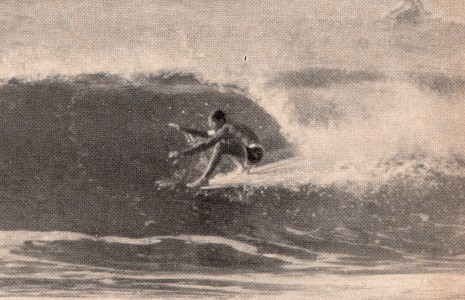 Here's a
beautiful tube ride for Johnny Peck at Haleiwa.
Peck builds up the ride by reaching out to hang five. |
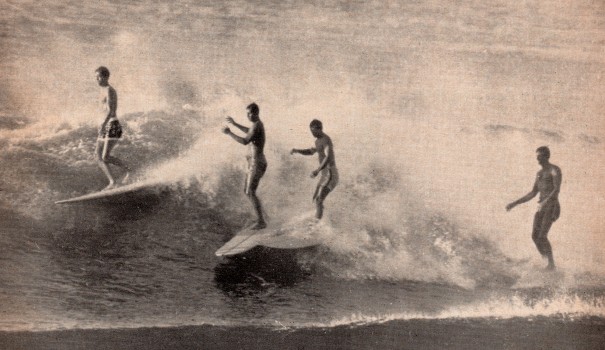 |
Curly Haleiwa with George Downing inside an unidentified surfer with Phil Edwards and John Peck making four. |
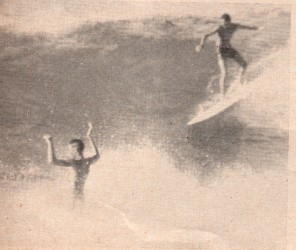 Multiple
lines of heavy swell kept over
50 surfers busy on this particular sunny day at Haleiwa beach. |
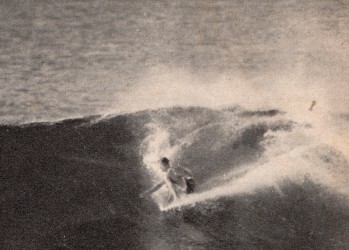 |
More on Haleiwa
A typical Peck surfing position hard up on a hollow. Fighting to
the last Butch is about to become
lunch.
|
 |
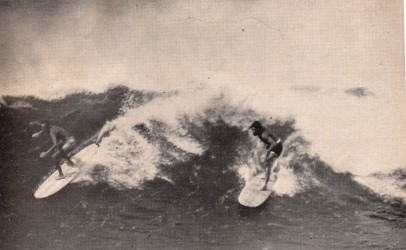 |
Right: With the wind howling off the mountains "Chollie" Cardiff of Dee Why drives right with "LJ" Richards. Left: Conrad Cunha plays it real cool at Haleiwa and drops down while Mick McMahon decides to go for broke. |
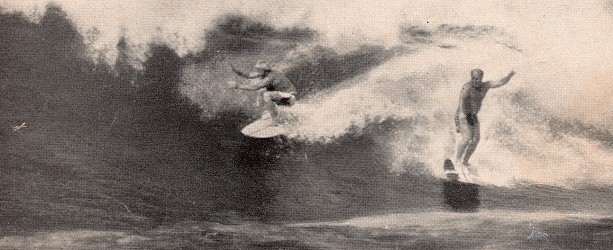 |
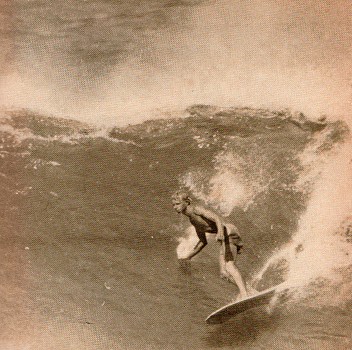 |
"Chollie"
Cardiff of Dee Why, well back against a
beautiful Haleiwa curl, receives a hefty
"rooster tail" from "Midget's" board as he
swings hard.
|
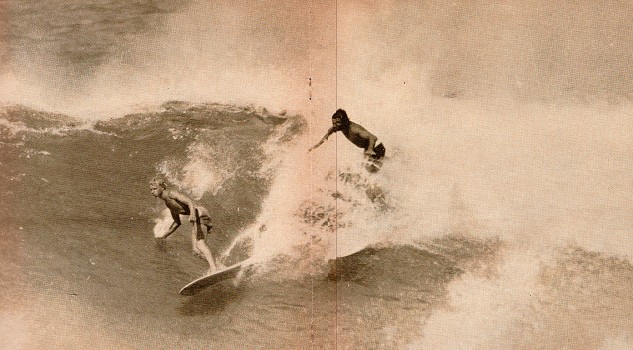 |
| The boys,
well-known in top Australian surfing circles, have
been on a surfing holiday in England and from
reports from John Campbell in a letter to Surfing
World it sounds like the holiday of a lifetime. "Conditions haven't been too crowded here with about six of us spread over eleven beaches which include Crantock, Fistral, Towan, Great Western, Tolcarne and Lusty Glaze. "Don't get the wrong idea from these photos, the surf is really good about every three weeks, but the rest of the time it is usually blown out. When this happens we all go to Towan and ride along the harbour wall which throws up four-footers on the right-side," John reports. "We have made quite a few English cobbers and have converted most of them into surf fans." John enclosed a clipping from an English newspaper which heralded their adventurous ride down the Severn. "We travelled overnight from the north Cornwall coast to try out this tidal wave," John said. "Everyone in the district we spoke to had talked about waves 12 to 14 feet high so we dived into the river with our boards and waited for the rise. "The local farmers thought we were stark raving mad and promptly called the police. The coppers came along and told us to leave the river but we explained that we were experienced surfboard riders who had ridden in the Atlantic and Pacific and thought we could handle an inland river. "So they left us alone convinced they would have four bodies to identify later on. "When the rise did come it was only four-foot high, quite easy to ride so Ian Tiley and I rode the wave for a mile. We couldn't swing either way but it was a long, long ride. "At the end of the ride I got out of the river on the left hand side and ended up in a paddock full of bulls. They started to move toward me so I bailed out and paddled over to the other shore and got out," John said. When John wrote his letter he and the gang were putting the finishing touches to their surf van. An apparently colorful waggon with all sorts of gremmy signs splashed all over it. Then they were heading for continental surfing resorts for a demonstration tour of surf riding |
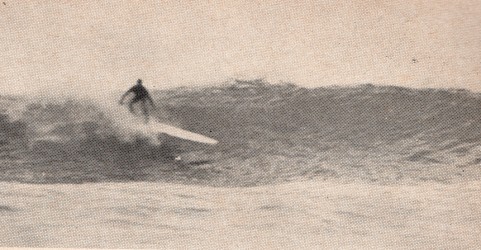 Warren
Mitchell rides this 11-ft balsa board
which was made by the members of the Channel Choppers Board Builders Club - Watergate Branch. 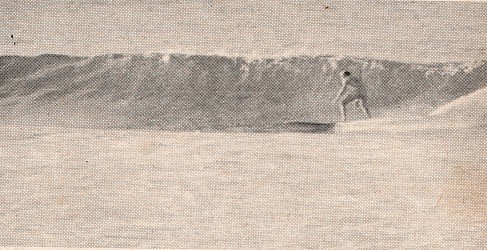 Christened "Billabong Bill" by his four Aussie mates newcomer to the surf Bill Bailie "goes home" as he slips along a neat wall at Fistral. |
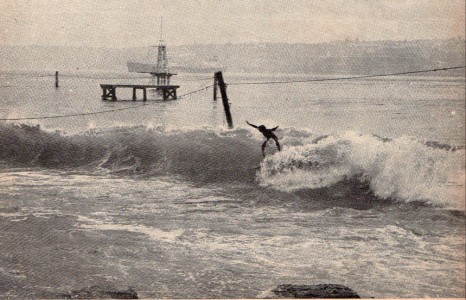 Normally a safe bathing beach inside Sydney Harbour, note the shark-net cable, and only breaks when the outside swell is huge. |
Ian Nicol stops this unknown rider at Nielsen Park. . |
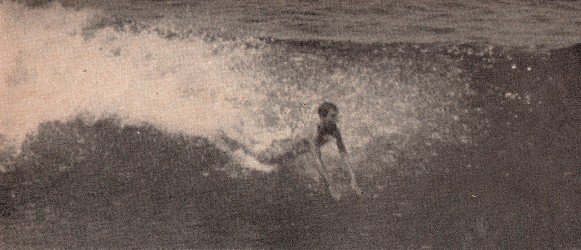 Graham Warr
opened out to f 11 at 500th to get this
unusual
action shot of Peter Scott at Wollongong. An extremely unusual "body-surfing" photograph; the surfer most probably launched from his surfboard, out of shot. |
|
ULLADULLA IS GOOD
By Jack ("Bluey") Mayes Most week-ends some Bondi riders and myself head north to our usual surfing grounds around Moonee, Nine-Mile or "Ghostie" and have been well satisfied with our results. But they say a change is as good as a holiday so we shifted orbits and went south. It was a good move as we found another new set of waves and, what's more, it's a good summer surf. Nowadays, with the way some of the crowds hit the suburban beaches it's enough to drive a man crazy having to fight for a place on a wave; and most of the new riders have little regard for the rules of surfing—it's no wonder so many are getting hurt. So we formed a solid team to look for quiet beaches with good humps. Camping out has become a regu¬lar feature for me and my surfing mates and we go hunting waves about three week-ends every month, so the long weekend of just a while back gave us a real holiday. |
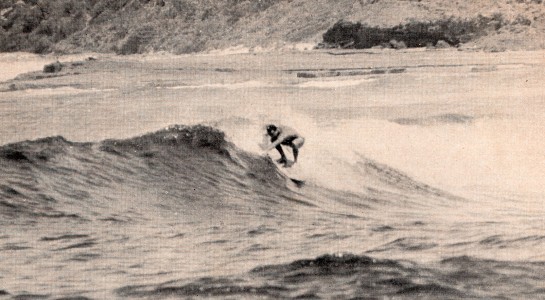 Things get
pretty tough for Bondi boardman Ray Cooke
as the inside reef approaches and the wall steepens. |
At Geroa and Gerringong there was a fair swell but the wind was turning to the east so it didn't interest us and we just drove on quietly through Berry to Nowra and, not too certain of the whereabouts of the well touted Green Island, decided to carry on to Mollymook. There were travelling boardsmen everywhere, but most wore long faces because of the poor weather and the majority were heading back to Sydney. Mollymook was small, as usual, but the reef outside was breaking a good-sized swell and John O'Donovan, who had sighted a good wave Page 29 just south of the Ulladulla Lighthouse one day, suggested we drive in along the long bush track and have a look. What we saw was rewarding. Nearly 500 yards offshore a swell bombora was setting up a promising wave - the coast takes a fair turn here and the east wind was almost parallel to the shore. It was late in the day and the boys (Ray Cooke, Johnny O'Donovan, Tony Rule, Terry Logue, "Wheels" Williams and myself decided "this must be the place." One of the
all time great boardmen "Bluey Mayes".
|
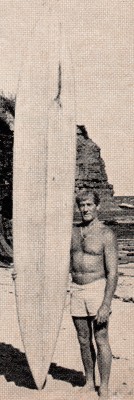 |
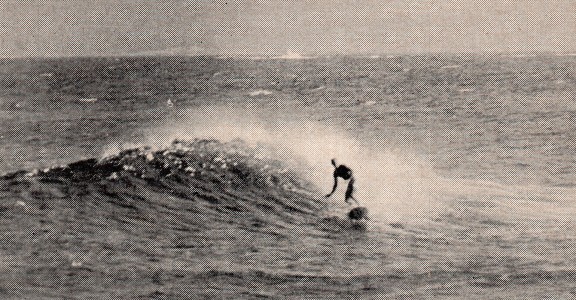 "Wheels"
Williams turns back into a five-foot swell.
|
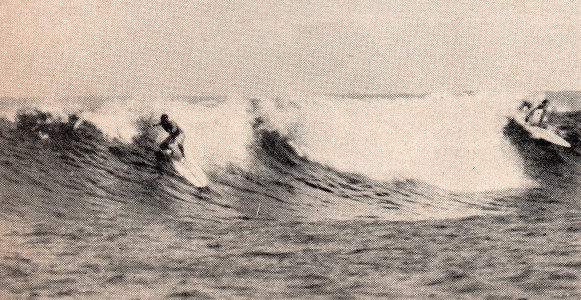 Ray Cooke
turns away from the peak on the outside reef.
|
|
Rincon
The Los Angeles smog comes down like a yellow haze and if you are a newcomer like myself it catches you in the throat and makes your eyes sting. Up on the 16th floor of the Tatler Hilton, where I was staying, the scene outside was reminiscent of a light duststorm with the sun just a dull yellow blob and the tiny people below almost invisible. However, the people of L.A. seem immune to all this. American surfer Bob Cooper who had been in Australia for most of last year, was generously driving-up from Summer land (about 70 miles away) to pick me up and I was frankly impatient to move out of this smog fog. Bearded Bob arrived right on time and in his characteristic relaxed way, greeted me as though it was only yesterday and five minutes walk from our last meeting. After spending a very pleasant one night stay at the home of Mr. and Mrs. Gil Cooper, we moved down to the coast at Tobanga Canyon; ate breakfast with surfing historian Professor David Stone and at the same time noticed an increase in the swell size at this really unusual wave location, right outside the "Prof's" front door. |
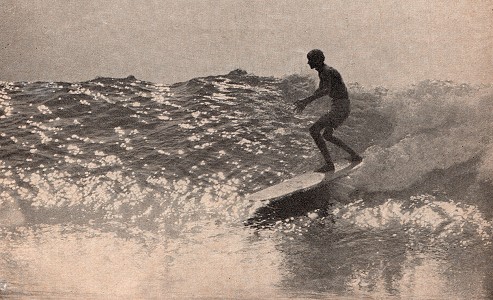
A young
Santa Barbara surfer has the rare pleasure of
seeing the sun reflected on this straight-topped wave. |
| Wipe-outs are
relatively frequent here because a surfer will tend
to move so far back inside the curl that he
stretches his chances of making the tube. Fortunately the stony bottom has been smoothed out by countless years of surging oceans; though after seven days of continuous waves and wading in and out the feet became somewhat tender. At low tide one day, while trying to do the impossible the collapsing tunnel threw me off the board to land on my back on a rock just under the surface. I'm still sore. Neither Midget or I can speak too highly of the friendly way in which we were received, and we are both grateful for the experience of a wonderful week at "The Rincon", with our old mate Bob Cooper. - Bob Evans.
A Japanese-American surfer lets this completely hollow tube fall flat his feet and comes through real late in a typical top Rincon fashion. |
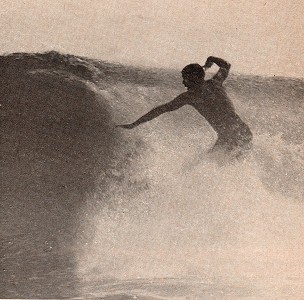 |
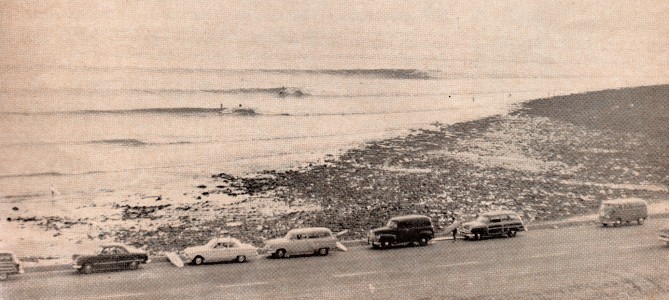
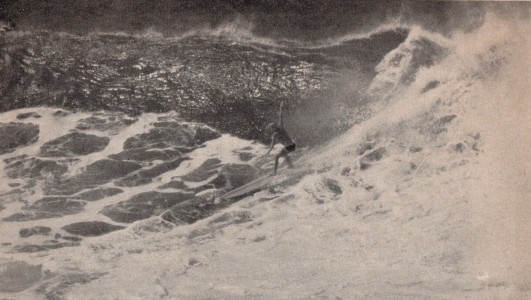 |
Page 32 Salty
Characters
... The
boil from the previous wave leaves Dave
Jackman
with a tangled track to negotiate on this Waimea giant. Back Page Morris 850 and surfboards. |
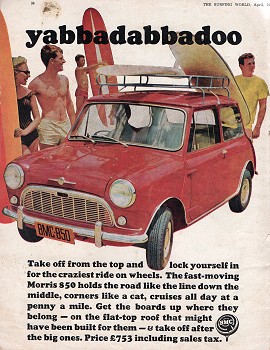 |
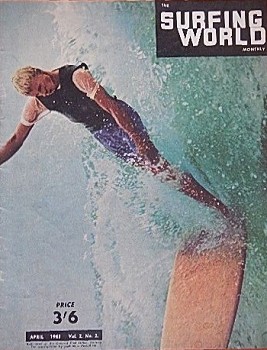 |
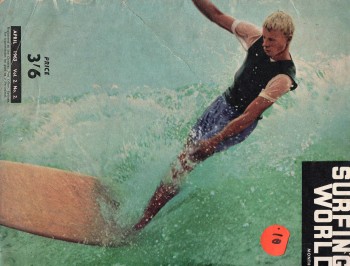 Midget Farrelly swings into the shore break at the end of a long run at Rincon Beach, California. |
|
|
|
|
|
|